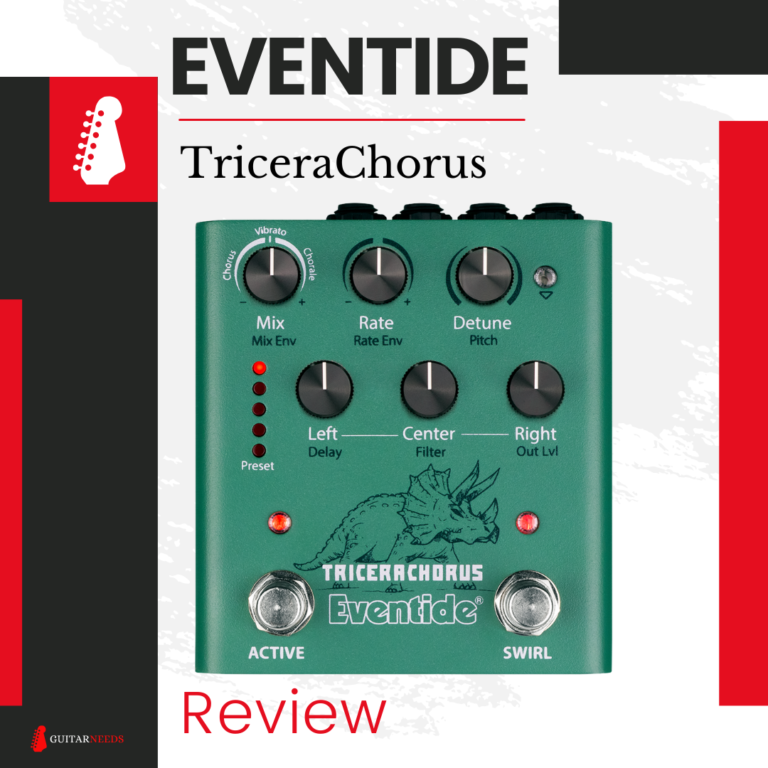This is my Eventide TriceraChorus Review.
Since the 1970s, Eventide has been making high-quality products where it has been pushing the boundaries of what is digitally possible. Now the innovative company has housed the versatile TriceraChorus plug-in in a pedal. My conclusion: this is a multipurpose stereo chorus that belongs on every guitarist’s pedalboard. It takes a little practice, but once you get the hang of it, the sounds are unmatched.
Eventide H9 Harmonizer effects
Eventide has become a renowned maker of plug-ins, pedals and rack-mount effects. Early successes included the Harmonizer effect processors and the SP2016 digital reverb.
In recent years, Eventide has released a number of effects from the famed H9 Harmonizer multi-effect pedal as plug-ins. Think of the Blackhole Reverb and the TriceraChorus. A logical next step was to release these plug-ins as standalone pedals. With this, the sound quality and countless options are now available to guitarists who like to hit the road with pedals.
Features
Eventide TriceraChorus Review

- Price indication: $ 300
- Three independent chorus voices: left, middle and right
- Three chorus types for a wide range of sound possibilities: Chorus, Vibrato, Chorale
- Special “Swirl” footswitch that can create psychedelic flanging, phasing and univibe sounds
- Five presets that can be loaded with the Eventide Device Manager (EDM) software, plus dozens more
- Active footswitch with two functions
- Guitar/line level switch on the rear panel for adjusting levels to guitar, synthesiser, FX loop or DAW interface
- Assignment of any parameter combination to an expression pedal
- MIDI capability via TRS (with MIDI-to-TRS cable or converter box) or USB (with MIDI host controllers)
- Multiple bypass options: Buffered, Relay, DSP+FX or Kill dry.
- The catch-up mode helps switching between presets/parameters while adjusting the sound
- Eventide Device Manager PC or Mac application for software updates, system settings and creating/saving presets
- LED: Effect On
- Footswitch: Effect Bypass, Swirl
- Input: 6.3 mm jack
- 2 Outputs: 6.3 mm jack
- EXP input
- Mini USB
- Mains adapter connection: Barrel connector 5.5 x 2.1 mm, negative polarity inside
- Power supply via 9 V DC mains adapter (not included in delivery)
- Dimensions (W x D x H): 102 x 108 x 43 mm
- Weight: 480 g
For
- Large selection of excellent modulation sounds
- Deep editing through app and ability to attach an additional expression pedal
- Complete stereo operation.
- Innovative Swirl footswitch.
Against
- Too much options for casual user?
- Expensive if you don’t use all the provided options.
- It takes some getting used to switching between primary and secondary settings.
Check price:
The TriceraChorus has a modest metal body. The push button on the top right of the pedal allows you to switch between the controls in white text (primary mode) and the controls in black text (secondary mode).
You won’t have this little box under control right away, but fortunately Eventide provides a reference guide with it, which is very helpful. For example, the reference guide describes that the swirl switch controls the preset mode by default. And that gives access to the five pre-programmed presets. When you press the swirl LED, the switch serves as an on/off for the swirl.
When you connect the TriceraChorus to your computer, the Eventide Device Manager gives access to 127 preset slots and 65 factory presets. This allows you to use the full capacity of the pedal. It allows you to try out new, radical sound settings to your heart’s content and save them directly to the backlog, or reject them. When you drag a preset to one of five spots, it’s directly on the pedal. Pack up and go!
Controls
In primary mode (large white labels) you can control the mix of the amount of chorus – vibrato – choral and dry signal (mix), speed (rate) and detuning (detune). The bottom three controls (left, center, right) you use to set the depth of three separate voices. They each have their own low frequency oscilator (lfo). Relative to the central signal, they are successively -120, 0 and +120 degrees out of phase. This is particularly audible in stereo.
The “mix envelope” controls when the rate and detune turn on. If you turn more to the left from the center then you get more effect as your signal decreases. If you turn more to the right, the effect decreases as the signal decreases. Thus you create a kind of fade-in effect or fade-out effect.
Then the secondary mode (smaller black labels): The rate envelope determines the speed of the lfo, depending on your attack. If you turn the control from the center to the right, then when you hit hard, the speed of the lfo is high. With time it then decreases to the level you set with the rate switch.
Sounds
The TriceraChorus has clearly taken inspiration from the bucket-brigade style choruses of the ’70s and early ’80s. By holding the lfo waveform at a deep angle in chorus mode, and turning the Mix knob three-quarters to the right, the waveform turns into a sinusoid at its highest point, and you can use the Eventide to approximate the ’70s and ’80s sounds quite well. The Mix is at 12 o’clock in Vibrato mode. If you turn the Mix knob to Chorus, you get a more variable sound, compared to the even chorus.
Detune lets you take advantage of Eventide MicroPitch technology and control the amount of detuning, as well as where it occurs in the mix (-40L/+40R to +40L/-40R).
The Swirl switch allows you to turn on a flanger, phaser or univebe-like sound depending on your settings. All the combination options offered by the pedal put a whole range of sounds at your disposal. If you are into choral experimentation, then this is the ultimate pedal for you.
The pedal already sounds great in mono, but comes into its own in a stereo setup. Via Left – Center – Right, for example, you can set up a subtle chorus on the right, while on the left you let the effect go full deipte, and balance in the center. You can also use the TriceraChorus as a subtle “always on” effect, with only the center control on or just create a huge soundscape that does something different everywhere in the mix.
The 65 pre-programmed presets are a good source of inspiration for creating your own sounds. Presets like the “Paschorius” and the “Slow Flange” give a good basic chorus, which you can give more phaser or flanger sound via the Swirl. A Leslie speaker-like sound can be found for example in the presets ‘Leslie False’ and ‘Warped LP’. Rotary effects (also extreme variants of them) can be found, for example, in the ‘ Reptilian’ and the ‘Shapeshifter’. In short, from the presets, you can tweak in all directions and create your own unique sounds.
Alternatives
- Strymon Ola Chorus Vibrato Pedal
- Universal Audio UAFX Astra Modulation Pedal
- Walrus Audio MAKO Series M1 High Fidelity Modulation Machine
- Fairfield Circuitry Shallow Water
- Read our Other Guitar Pedal Reviews
Verdict
When you turn on the pedal, you are immediately won over by the bucket-brigade-like sounds. But the party has only just begun then. This pedal has struck a wonderful balance between classic chorus sounds in an old school pedal housing, and digital options that allow you to create all sorts of presets via computer. It allows you to experiment in a comfortable way. Whatever chorus sound you’re sweet on, with the TicerChorus you’re sure to find it.

Check price:





